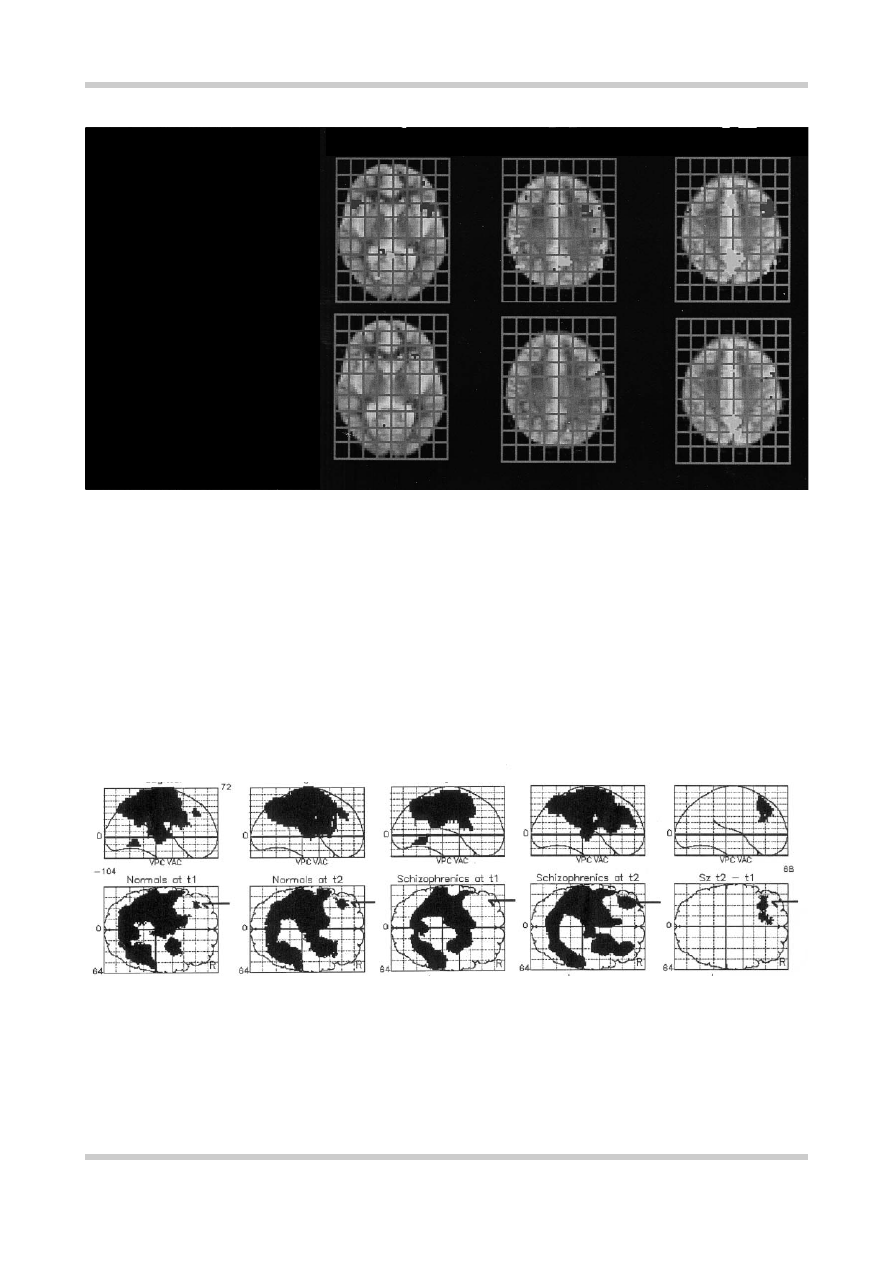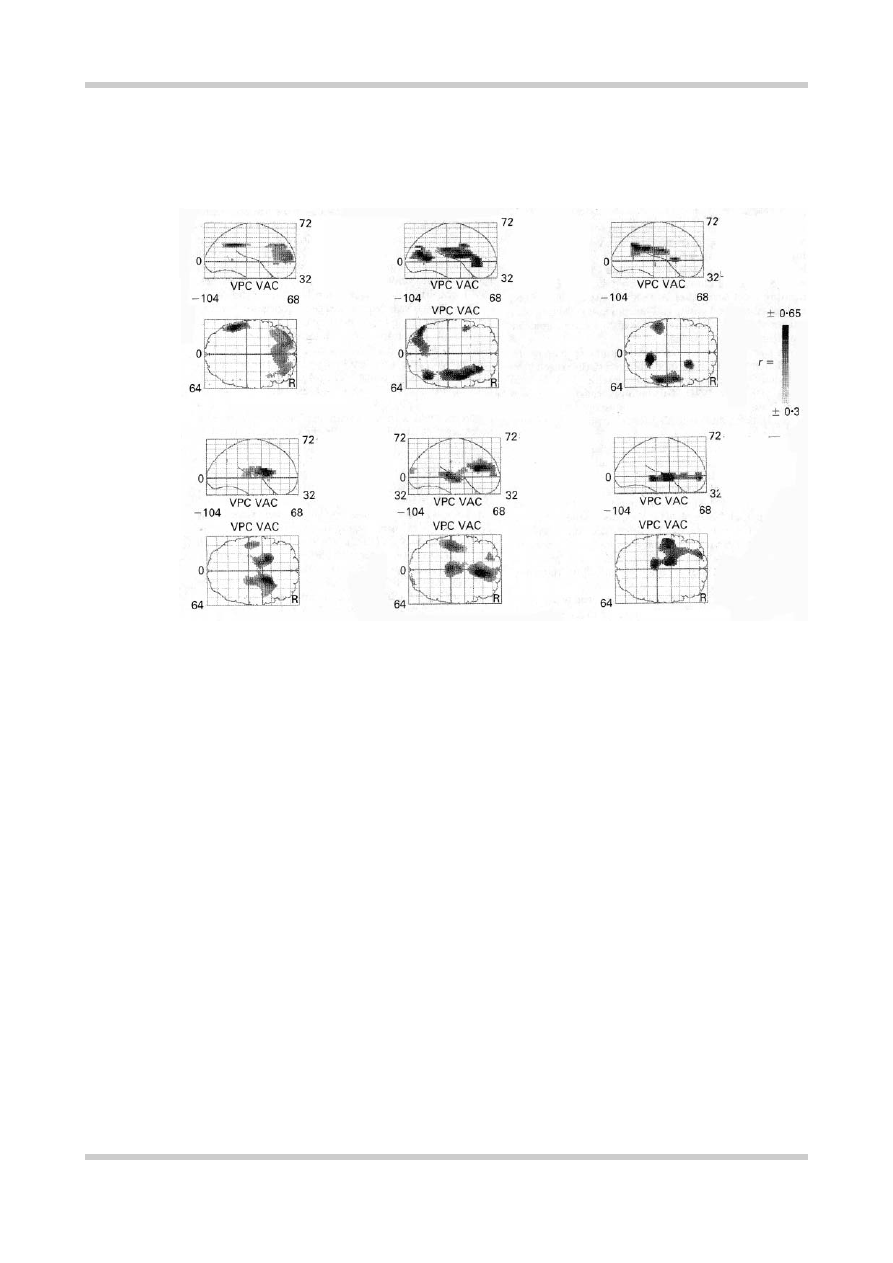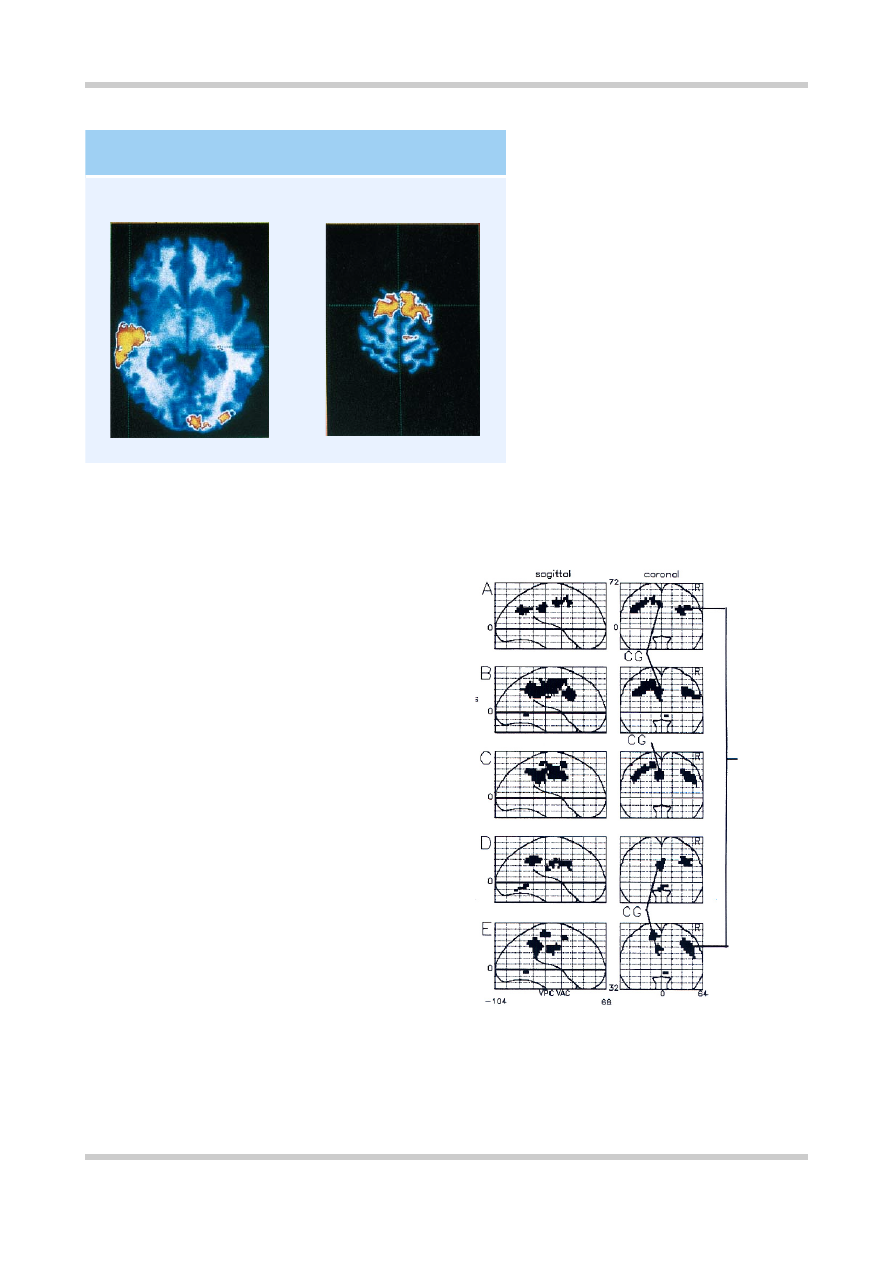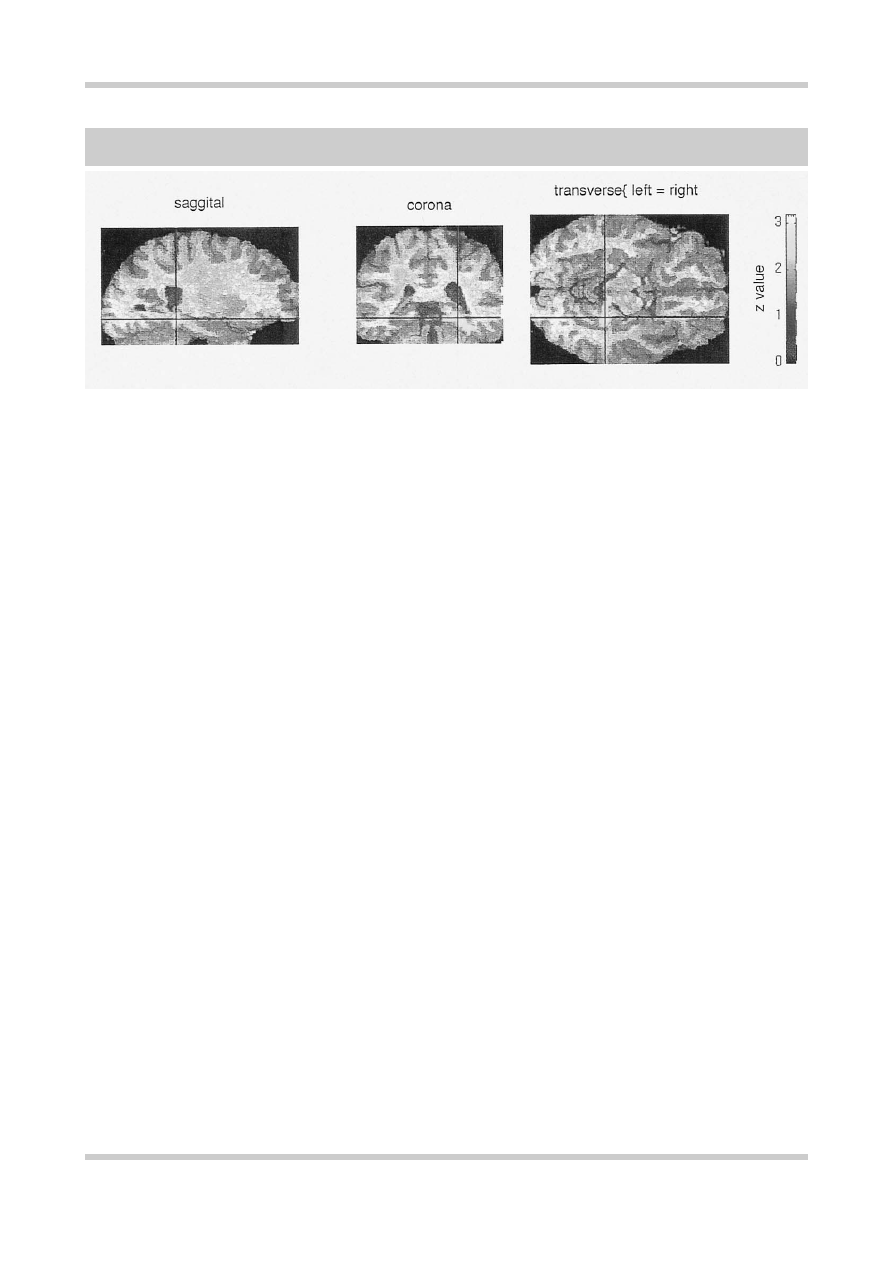ВУЗ: Не указан
Категория: Не указан
Дисциплина: Не указана
Добавлен: 02.10.2020
Просмотров: 1300
Скачиваний: 6

©2002 CRC Press LLC
Figure 3.10
Verbal fluency and frontal lobe blood flow in schizophrenia. Comparison using functional magnetic resonance imaging
between five right-handed male schizophrenic patients and five matched controls performing a covert verbal fluency task. The
schizophrenic patients showed a comparatively reduced response (red) in the left dorsal prefrontal cortex and inferior frontal gyrus,
and an increased response (orange) in the medial parietal cortex. Figure reproduced with permission from Curtis VA, Bullmore ET,
Brammer MJ,
et al.
Attenuated frontal activation during a verbal fluency task in patients with schizophrenia.
Am J Psychiatry
1998;
155:1056–63
CONTROLS
PATIENTS WITH
SCHIZOPHRENIA
Figure 3.11
Hypofrontality in a motor activation task remitting with recovery from schizophrenic relapse. This study shows
changes over time in neuronal response in a positron emission tomography study of willed action using a simple motor task.
Prefrontal cortical activation not apparent at time 1 in the schizophrenic subjects (when they were acutely ill) becomes
apparent at time 2, 4–6 weeks later. The figures show statistical parametric maps thresholded at
p
< 0.05, Bonferrroni
corrected. Figure reproduced with permission from Spence SA, Hirsch SR, Brooks DJ, Grasby PM. Prefrontal cortext activity
in people with schizophrenia and control subjects. Evidence from positron emission tomography for remission of
‘hypofrontality’ with recovery from acute schizophrenia.
Br J Psychiatry
1998;172:316–23
MOTOR ACTIVATIONS AT TWO POINTS IN TIME 4–6 WEEKS APART
Normals at time 1
sagittal
Normals at time 2
sagittal
Schizophrenics at t1
sagittal
Schizophrenics at t2
sagittal
Sz t1–t2
sagittal

©2002 CRC Press LLC
not shown these differences between schizo-
phrenics and controls. Although some studies have
suggested that differences in rCBF between
patients and controls are persistent, others have
found that they appear to be state dependent, and
remit with treatment (
Figure 3.11
)
7
.
A number of studies have attempted to
correlate patterns of brain activation with specific
symptoms or syndromes of schizophrenia. Liddle
and colleagues
8
(
Figure 3.12
) investigated the
three syndromes of psychomotor poverty, disorg-
anization (i.e. inappropriate affect, speech content
abnormalities), and reality distortion (i.e.
delusions and hallucinations). They found that
reduced rCBF in the left and medial prefrontal
cortex correlated with psychomotor poverty; the
severity of disorganization correlated with
increased rCBF in the right medial prefrontal
cortex and decreased perfusion in Broca’s area;
and reality distortion correlated with increased
rCBF in the left hippocampal formation. Studies
of schizophrenic patients with and without
auditory hallucinations have shown increased
blood flow to Broca’s area when patients are
hearing voices. Furthermore, patients prone to
auditory hallucinations show abnormal patterns of
blood flow when asked to imagine hearing voices,
compared with normal controls (
Figure 3.13
)
9
,
and patients with schizophrenia also appear to
demonstrate abnormal patterns of temporal cortex
activation in response to external speech.
Abnormal patterns of blood flow also appear to be
related to other specific symptoms of schizo-
phrenia, including passivity phenomena (
Figure
3.14
)
10
and formal thought disorder (
Figure
3.15
)
11
. Interest is focusing increasingly on the
Figure 3.12
Statistical parametric maps showing pixels in which there are significant correlations between rCBF and
syndrome score, for the three syndromes of psychomotor poverty, disorganization and reality distortion. Different syndromes
of schizophrenia may have different patterns of aberrant rCBF. Figure reproduced with permission from Liddle PF, Friston KJ,
Frith CD,
et al
. Patterns of cerebral blood flow in schizophrenia.
Br J Psychiatry
1992;160:179–86
REGIONAL CEREBRAL BLOODFLOW (rCBF)
AND SYNDROMES OF SCHIZOPHRENIA
Negative
correlations
Positive
correlations
Psychomotor
poverty syndrome
Disorganization
syndrome
Reality distortion
syndrome

©2002 CRC Press LLC
Figure 3.13
This study investigated the
hypothesis that a predisposition to verbal
hallucinations is associated with a failure to
activate areas concerned with the monitoring of
inner speech. Subjects, who included patients
with schizophrenia both with and without a
significant history of hallucinations, as well as
normal controls, were asked to imagine senten-
ces being spoken in another person’s voice. The
figure illustrates positron emission tomography
data superimposed on a normal magnetic
resonance imaging scan, and shows reduced
activation in the left middle temporal gyrus and
the rostral part of the supplementary motor area
in hallucinators compared to non-hallucinators.
Similar findings were found in the comparison
between schizophrenic patients and controls.
Figure reproduced with permission from
McGuire PK, Silbersweig DA, Wright I. Speech:
a physiological basis for auditory hallucinations.
Lancet
1995;346:596–600
SEROTONINERGIC PATHWAYS
INNER SPEECH AND AUDITORY HALLUCINATIONS
0 mm +60 mm
Figure 3.14
Positron emission tomography study of schizophrenic patients with passivity phenomena. This study looked at
patients with schizophrenia who were also experiencing passivity phenomena (delusions of alien control) during a voluntary
movement task. Hyperactivity is seen in these patients compared with normal controls (A), compared with other
schizophrenic patients (B and C), and with themselves as their symptoms resolve (D and E). In each case, greater activation
is seen in the right inferior parietal lobule (IPL), and at loci within the cingulate gyrus (CG). Figure reproduced with permission
from Spence SA, Brookes DJ, Hirsch SR,
et al.
A PET study of voluntary movement in schizophrenic patients experiencing
passivity phenomena (delusions of alien control).
Brain
1997;120:1997–2011
Compared with normals
– free movement minus rest
Compared with other schizophrenic patients
– free movement minus rest
–stereotypic movement minus rest
Compared with themselves at time 2
– free movement minus rest
–stereotypic movement minus rest
RELATIVE HYPERACTIVATION IN PATIENTS WITH PASSIVITY
Right
inferior
parietal
lobule

©2002 CRC Press LLC
Figure 3.15
PET data have been mapped onto a normal magnetic resonance image of a brain in standard stereotactic space,
sectioned to provide transverse, coronal and sagittal views. The left side of the brain is shown on the left side of the image.
The images show positive correlations between the severity of positive thought disorder and regional cerebral blood flow at
the junction of the left parahippocampal and fusiform gyri (marked by cross hairs), and in the anterior part of the right
fusiform gyrus. Figure reproduced with permission from McGuire PK, Quested DJ, Spence SA,
et al.
Pathophysiology of
‘positive’ thought disorder in schizophrenia.
Br J Psychiatry
1998;173:231–5
patterns of correlation in brain activity between
different brain areas, giving rise to the concept of
functional dysconnectivity, the idea that there is
impaired integration of cortical activity between
different areas of the brain, rather than a specific
focal abnormality or group of abnormalities.
NEUROCHEMISTRY
The primary neurotransmitters implicated in the
pathogenesis and treatment of schizophrenia are
dopamine and serotonin. Recent theories have also
implicated glutamine and
γ−
aminobutyric acid
(GABA). The neurochemistry of schizophrenia is
discussed fully in
Chapter 4
.
PSYCHOPHYSIOLOGY
A crucial research problem in the etiology of
schizophrenia is the difficulty in confidently
defining a phenotype. One of the main goals of
psychophysiological research in schizophrenia has
been to identify trait markers that might identify
people vulnerable to developing the disorder even
if they are asymptomatic.
Two promising trait markers have emerged.
Eye tracking disorder, i.e. abnormalities of smooth
pursuit eye movements, have been described in
people with schizophrenia and their relatives.
Abnormalities in the auditory evoked potential
have also been described, e.g. diminished ampli-
tude and increased latency in the P300 response to
an ‘oddball’ auditory stimulus, which appears to
show both trait and state abnormalities (
Figures
3.16
and
3.17
)
12
.
NEUROPSYCHOLOGY
Various theories propose mechanisms that link
abnormal neuropsychology in schizophrenia to its
symptoms, and the functional neuroimaging
techniques described above have begun to provide
an important tool in beginning to unravel these
relationships. For example, schizophrenic symp-
toms may arise from faulty attentional processes
or ‘central monitoring’, and, as a result, the capa-
city to distinguish between internal and external
stimuli may be impaired (leading, for example, to
the experience of hallucinations). Disorders of
volition, which are clearly important at the
clinical level, may also have specific neuro-
psychological substrates.
Understanding the
relationships between symptoms, cognitive func-
tion and neurochemistry has become an impor-
tant new goal in researching the mechanisms of
drug action.
FUNCTIONAL IMAGING OF FORMAL THOUGHT DISORDER IN SCHIZOPHRENIA
©2002 CRC Press LLC
Figure 3.16
Abnormalities in
evoked potentials have
consistently shown abnormalities
in schizophrenia. The P300
auditory event-related potential
(ERP), seen here as one of several
components of the auditory ERP,
is seen as a response to ‘oddball’
or unexpected stimuli, and
shows robust changes in both
amplitude and latency in
schizophrenic patients and their
relatives.
–5
µ
V
1000
+5
µ
V
Time (msec)
Stimulus
onset
100
10
Amplitude
P
300
AUDITORY EVENT-RELATED POTENTIALS
Figure 3.17
These data suggest
an increased P300 latency in
patients with schizophrenia and
their relatives when there is a
strong family history of schizo-
phrenia (+FH), but not in
sporadic cases (–FH). P300
latency may be an important
trait marker for the genetic
vulnerability to schizophrenia.
Figure reproduced with
permission from Frangou S,
Sharma T, Alarcon G,
et al
. The
Maudsley Family Study, II:
Endogenous event-related
potentials in familial
schizophrenia.
Schizophr Res
1997;23:45–53
0.50
0.45
0.40
0.35
0.30
Mean latency
–FH
schizophrenics
–FH
relatives
Controls +FH
relatives
+FH
schizophrenics
P300 LATENCY IN SCHIZOPHRENIA